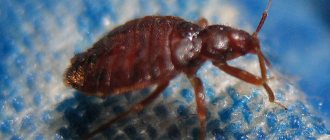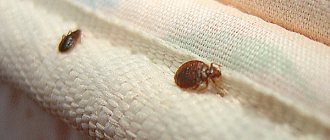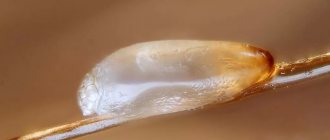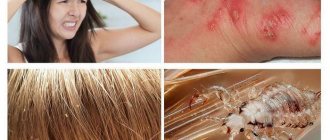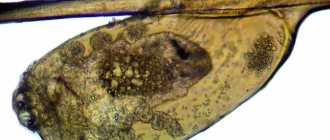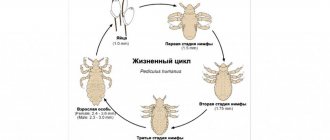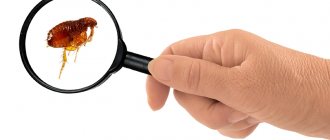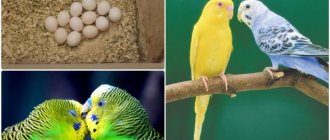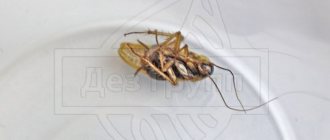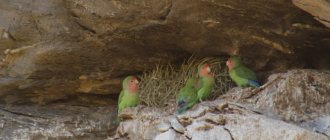Lice
- these are creatures that live absolutely anywhere in the world. life expectancy is about a month. These are unique arthropod insects, whose life is directly related to the human body and blood.
Getting rid of these parasites is problematic, since they reproduce at lightning speed, and their larvae are quite difficult to remove and getting rid of them is also problematic even with modern drugs. Once upon a time there was a legend that people with lice would be rich and happy. But it’s hard to believe, since the word “lice” immediately scares away and instills fear. People who have lice try in every possible way to hide this fact so as not to scare off those around them. It is believed that these parasites live only in human hair and have no specific place of residence. But this is far from true. In the article you will learn the whole truth about these insects (where they come from, how to fight them and what danger they pose to humans and their environment).
What do lice look like?
These parasites are microscopically small, barely reaching five millimeters in size. They have a clearly defined abdomen, but the head, on the contrary, is very small. They practically do not see, they keep their orientation solely by smell. Amazing fact: lice have wings, but they are also small in size and therefore they do not fly.
The oral apparatus of lice is of the piercing-sucking type with a proboscis and two needles. When a louse begins to feed on blood, its proboscis sticks out and attaches itself to a specific puncture site in the skin. When a bite occurs, saliva is released, which prevents blood clotting and subsequently causes itching on the human skin. Important point. Lice cannot completely penetrate human skin; only the proboscis gets there, which pumps out blood. They linger on the hair thanks to three pairs of legs, at the ends of which there are claws. Lice move at a speed of 20 centimeters per minute. It’s scary, but lice attach their nits, that is, larvae, to the hair on a sticky substance. With large fertilization, the female can lay several hundred eggs at a time. Hatching time is about sixteen days.
Who lives under the skin?
A subcutaneous louse is none other than a scabies mite . These parasites are much smaller than lice (an adult can only be seen under a microscope).
There are no external similarities between ticks and lice. A tick differs from a louse both in its lifestyle and in its method of reproduction. And the tick has more limbs (8, whereas the louse has only 6).
And one more significant difference. Lice live in one place, and the mite migrates under a person’s skin, laying more and more new larvae and literally gnawing through passages.
Life cycle of lice
In general, lice are quite tenacious.
They can adapt to any environment, be it hot or cold. Also, together with a person, they can stay under water for a long time. Surprisingly, nits (lice larvae) are much more tenacious than the lice themselves; even some chemicals do not kill them. They feed exclusively on human blood. When bitten, a person only feels itching and cannot even think that at that very moment a louse is biting him. Life expectancy is about 28 days. During this time, the female lays more than 200 eggs, and this carousel never ends.
When a person begins to fight lice, he pays close attention to this moment. That is why the fight against parasites takes about a month to overcome both adults and their offspring.
Symptoms
The fact that a person has itching can be noticed from the moment it appears. Because you immediately feel some discomfort. Most often, the subcutaneous mite settles in those places of the dermis where there is no hair.
Unlike the parasite itself, their passages are clearly visible. The presence of subcutaneous lice can be understood by the following symptoms. A person develops a red rash in the places where the tick parasitizes, and the following are observed:
- hot flashes;
- slight increase in temperature;
- swelling gradually turning into a blister.
Tick larvae and females in search of blood cause severe itching. The peak activity of subcutaneous ticks occurs from 3 to 6 am. It is at this time that the itching becomes unbearable. It is almost unbearable to endure this malaise. Because of it, a person’s psychological state worsens. The resulting stress is also considered a sign of illness. During the day a person hardly itches.
How do lice reproduce?
In order for a female to become fertilized, one mating is enough and after that a “repeat procedure” is no longer required.
If one fertilized female gets on a person’s hair, then after a few days about a hundred nits will live on the hair. A few hours after fertilization, the female begins to gradually lay eggs on the human hair and tightly glue them to this same hair.
After a week or a week and a half, the upper lid of the egg bursts and a young nymph emerges from there. She immediately begins to suck blood, which leads to her reaching full maturity eight days later. If suddenly the nit does not find a food source, then within a day it will completely die from dehydration. Now imagine that hundreds of these nits live in your hair, constantly sucking your blood.
Disinsection of things, premises
Treating bedding for lice is carried out by washing in hot water or boiling for 5 minutes. Finally, iron with steam.
Particular attention is paid to folds and seams
Bedding should be changed on the first day of treatment, after taking a shower after 5 days. Last time after 2 weeks, if no new symptoms appear.
Outside the human body, the scabies mite can live for about a week under favorable conditions. Almost instantly dies from hot water, low temperatures, the sun's rays kill subcutaneous lice on things in 3 days.
It is also necessary to disinfest the premises. Carry out general cleaning and wet cleaning. A product containing bleach is added to the water. Door handles, armrests on chairs, sofas, beds, and tables are wiped with special care. You need to go over all the furniture in the house, and finally wash the floor. The procedure should be repeated every day while treatment is ongoing. Clothes are washable.
The main prevention of scabies is washing your hands with soap, especially household soap, after each visit to a public place, before eating.
Lice diet
As mentioned earlier, lice feed exclusively on human blood; their bodies are designed in such a way that only blood is available to them.
Some people believe that if there is a lack of blood, lice can feed on both dandruff and the hair itself. This is far from true. They simply cannot feed on hair. The frequency of blood suction occurs 5 times a day, every 2–3 hours. In one suction, a louse is capable of pumping up to 0.5 ml of blood from the human body. After complete saturation, lice are able to reproduce further.
What caused this misconception?
There are several facts that allowed such a fiction to gain such great popularity.
The insects are small in size, so not everyone can notice them. Because of this, many people believe that if parasites are practically invisible in the hair, then they cannot be detected under the skin.
The similarity of the symptoms of scabies and pediculosis is the presence of similar irritation and continuous itching. If, with such symptoms, lice are found on the head, then they are automatically considered the culprits of the disease.
The causative agent of scabies is microscopic in size and cannot be seen with the naked eye. And in order to have a logical explanation, the subcutaneous parasite was invented.
Modern science has studied both scabies and lice quite well. And she made an unequivocal conclusion that one has nothing to do with the second.
How long do lice live and how do they die?
As mentioned earlier, a louse can live for 38 days.
At the same time, she can live without food for only 10 days, if there are comfortable conditions for her existence. If the air temperature is more than 45 degrees, only then will the lice begin to die. These insects can live for a couple of days in cold water and this is how they get onto the human body when swimming in a river or pool.
When a person is shaved bald, lice will not be able to survive, since they have nowhere to hide and they will not be able to stick their offspring. Consequently, they will be discovered and destroyed.
There are drugs that can deal with lice in a couple of doses. These drugs will be discussed below. For now, let's look at the types of lice.
- Head louse
. It lives exclusively on the human head, in the hair. - Pubic louse
. This type is based on the human genitals (armpits, eyebrows, beard - all those genitals where there is hair). - Body louse
. Habitat: clothes and linen. It also feeds exclusively on human blood.
Ways of infection with pediculosis
The most basic way you can catch parasites is through direct contact with infected people. The head louse moves from head to head when touched or if you simply pass or stand very close to an infested person. Insects move through hair very quickly. Pubic lice pass from one person to another during sexual intercourse or while sleeping in the same bed in close proximity.
The second way is when using the personal belongings of an infected person. Lice can be found in a variety of objects:
- hats;
- clothing and underwear;
- combs, hairpins, elastic bands and other hair accessories;
- towels;
- bed sheets;
- pillows and blankets.
You can easily catch lice on public transport. On the seats of trains, buses, and planes, especially on soft textile headrests, including those with individual napkins, insects can go unnoticed and easily move from there onto their heads.
Ways to get rid of parasites
Pediculosis is not able to resolve and go away on its own.
If the disease is not treated, then over time the number of lice will increase, the individuals will grow, which will significantly prevent the victim from feeling normal. There are two ways to combat nits - mechanical and chemical. But where would we be without folk recipes? This option is more related to the chemical method and will also be discussed in the article.
Mechanical methods
This includes methods such as: shaving bald, combing out parasites with a strong comb.
You can also apply thermal effects with a hair straightener or tongs. Not everyone likes a haircut, especially girls and women who are not ready to take such radical measures. And not all men will want to say goodbye to their haircut. These two methods must be combined, since it will not be enough to buy a product at the pharmacy and use only it. After the procedure, it will be necessary to comb out dead nits from the hair with a comb. The thing is that some drugs do not completely destroy nits; their shell reliably protects them from chemical exposure.
Also, in order to comb out all the nits, a regular curl of hair will not work. The comb should be strong, strong and with teeth that are located very close to each other.
Chemical methods
Currently, quite a lot of chemicals are produced to combat these pests. They differ in price, quality, consistency and method of application. So, let's look at the most effective ones:
- Shampoos.
Hygia, Lavinal. These brands are quite effective if used as written in the instructions. They are relatively inexpensive, but the results are guaranteed. There are also separate shampoos produced specifically for children. - Sprays.
They are more effective than shampoos, but they are more expensive, there is more hassle in carrying out the procedure, and, no less important, they are poorly washed off the head. Usually, a comb is included with the sprays. - Aerosols.
They are designed for processing clothing and bedding. There are quite a lot of brands, some simply use Dichlorvos. - Creams.
Less commonly found in stores and pharmacies, they are in no way inferior in effectiveness to sprays. - Combs.
They differ from ordinary combs and are intended only for combing out dead animals. Use in combination with sprays or shampoos. As an independent remedy, it will not give maximum effect.
Linen lice can be removed by thoroughly washing the laundry and then ironing it at high temperatures.
Lice and nits appeared on eyelash extensions, what to do?
Many people believe that parasites cannot appear on eyelash extensions. However, this situation occurs because the parasite feeds on blood, receiving it through the skin of the eyelid. Artificial material does not protect against parasite infection.
If such an unpleasant situation occurs, it is necessary to remove the eyelash extensions and then continue treatment using standard methods.
Recommendations
- Rapini, Ronald P.; Bologna, Jean L.; Iorizzo, Joseph L. (2007). Dermatology: 2-volume set
. St. Louis: Mosby. ISBN 978-1-4160-2999-1. - "How to treat nits." nhs.uk.
_ September 14, 2012. Archived from the original October 17, 2014. Retrieved October 23, 2014. - "kuti". Dictionary.reference.com
. Archived from the original November 7, 2014. Retrieved October 23, 2014. - ^ a b c d f g
"Parasites - Lice - Frequently asked questions about lice.
" cdc.gov
. September 24, 2013. Archived from the original October 15, 2014. Retrieved October 23, 2014. - ^ a b c d f g h i j k l m p o p q r s t
( August 2012).
"Incurable itch: head lice." Canadian family doctor
.
58
(8):839–41. PMC 3418981. PMID 22893334. - ^ a b c d f g gram hour i
Feldmeier H (September 2012).
"Capital pediculosis: new perspectives on epidemiology, diagnosis and treatment." European Journal of Clinical Microbiology and Infectious Diseases
.
31
(9):2105–10. doi:10.1007/s10096-012-1575-0. PMID 22382818. S2CID 18287060. - ^ a b c d f g gram h i j k l m p o p q
“Head lice.
Dimethicone is the best pediculicide.” President International
.
23
(151): 187–90. July 2014 PMID 25162097. - "Parasites - Lice - Lice." cdc.gov
. September 24, 2013. Archived from the original November 23, 2014. Retrieved October 23, 2014. - ^ a b
Takano-Lee M., Edman J. D., Mullens B. A., Clark J. M. (December 2004).
"Home Remedies for Head Lice Control: An Evaluation of Home Remedies for Control of Human Head Lice, Pediculus humanus capitis (Anoplura: Pediculidae)." Journal of Pediatric Nursing
.
19
(6): 393–8. doi:10.1016/j.pedn.2004.11.002. PMID 15637580. - Rozsa L, Apari P (May 2012). “Why infect loved ones - innate human behavior indicates a past mutualism with head lice.” Parasitology
.
139
(6):696–700. Doi:10.1017/S0031182012000017. PMID 22309598. - ^ a b c
Department of Parasitic Diseases (DPD), National Center for Zoonotic, Vector-Borne and Enteric Diseases (ZVED) (16 May 2008).
“Head Lice Fact Sheet.” Centers for Disease Control and Prevention website
. Atlanta, GA: US Government Department of Health and Human Services. Archived from the original March 7, 2010. Retrieved May 28, 2010. - ^ a b
Devore CD, Schutze GE (May 2015).
"Pediculosis". Pediatrics
.
135
(5):e1355-65. Doi:10.1542/peds.2015-0746. PMID 25917986. - Hoffman B.L., Williams J.W. (2012). Williams Gynecology
(2nd ed.). New York: McGraw-Hill Medical. paragraph 90. ISBN 9780071716727. OCLC 779244257. - Pollack R. J., Kishevsky A. E., Szpilman A. (August 2000). "Overdiagnosis and resulting mismanagement of head lice infestations in North America." Journal of Pediatric Infectious Diseases
.
19
(8): 689–93, discussion 694. doi:10.1097/00006454-200008000-00003. PMID 10959734. S2CID 2557006. - ^ a b
Mumcuoglu K.Yu., Friger M., Ioffe-Uspensky I., Ben-Ishai F., Miller J. (2001).
"Lice comb versus direct visual inspection for diagnosing head lice infestation." Pediatric dermatology
.
18
(1): 9–12. Doi:10.1046/j.1525-1470.2001.018001009.x. PMID 11207962. S2CID 27464495. - Williams LK, Reichert A, McKenzie WR, Hightower AW, Blake, PA (May 2001). "Lice, nits and school politics." Pediatrics
.
107
(5):1011–5. doi:10.1542/pedy.107.5.1011. PMID 11331679. - ^ a b
Mumcuoglu KY, Barker SC, Burgess IE, Combescot-Lang C, Dalgleish RC, Larsen KS, Miller J, Roberts RJ, Taylan-Ozkan A (April 2007).
"International guidelines for effective control of head lice." Journal of Drugs in Dermatology
.
6
(4): 409–14. PMID 17668538. - Kidshealth.org - Head Lice, page-3 Archived 2010-10-14 on the Wayback Machine
- Weems Jr., Howard Vincent; Fasulo, Thomas R. (July 1999). "Turkey and head louse, Pediculus spp." Department of Entomology and Nematology
. University of Florida. Archived from the original on October 4, 2011. Retrieved June 15, 2022. - ^ a b c
Goats B.M., Atkin J.S., Wilding K.G., Birch K.G., Cottam M.R., Bush S.E., Clayton D.H.
(November 2006). "An Effective Non-Chemical Treatment for Head Lice: Lots of Hot Air." Pediatrics
.
118
(5):1962–70. Doi:10.1542/peds.2005-1847. PMID 17079567. S2CID 9482708. - Burgess IF (May 2011). "Pediculosis". BMJ Clinical Evidence
.
2011
. PMC 3275145. PMID 21575285. - "Abametapyr: FDA-approved drugs." US.
Food and Drug Administration (FDA) . Retrieved July 25, 2022. - Jacobi, T. (September 22, 2011). "The Basics - Treating Head Lice." GP
: 38. Archived from the original on July 16, 2015. Retrieved October 22, 2014. Overall, the evidence for alternative treatments such as tea tree oil and neem seed oil remains weak. - "Tea tree oil". Medline Plus, a service of the US National Library of Medicine of the National Institutes of Health. July 27, 2012 Archived from the original July 25, 2010
- Eisenhower C, Farrington EA (2012). "Advances in the treatment of pediatric lice." Journal of Pediatric Health Care
.
26
(6): 451–61, Quiz 462–4. doi:10.1016/j.pedhc.2012.05.004. PMID 23099312. - "CDC - Frequently Asked Questions - Healthy Water for Swimming and Recreation - Healthy Water." CDC.gov. October 22, 2012. Archived from the original October 28, 2012. Retrieved November 22, 2012.
- Michigan Head Lice Guide
.
State of Michigan. 2004[ page needed
] - Hootman J (April 2002). "Quality Improvement Projects Related to the Treatment of Head Lice." Journal of the School Nurse
.
18
(2): 80–6. Doi:10.1177/10598405020180020401. PMID 12017250. S2CID 29291526. - Norman G. Gratz (1998). “Human lice: their prevalence, insecticide control and resistance. Review 1985–1997" (PDF). Geneva, Switzerland: World Health Organization. Archived from the original (PDF) on May 8, 2007. Retrieved January 2, 2008. Journal Citation Requires | log = (help)
- ^ a b
"Modern problem: parents scratching their heads over lice." Consumer Reports. February 1998, pp. 62–63. Retrieved October 10, 2008. - Burgess IF (2004). "Human lice and their control." Annual Review of Entomology
.
49
: 457–81. Doi:10.1146/annurev.ento.49.061802.123253. PMID 14651472. - "Symptoms and treatment of head lice and nits." www.nhsinform.scot
. Retrieved January 23, 2022. - Musazadeh M., Afshari M., Keyan H., Nezammahalle A., Enayati A.A. (December 2015). "Prevalence of head lice infestation and associated factors among primary school students in Iran: a systematic review and meta-analysis." Oson Public Health and Research Perspectives
.
6
(6): 346–56. doi:10.1016/j.phrp.2015.10.011. PMC 4700766. PMID 26835244. - ^ a b c d
Nutanson I, Steen CJ, Schwartz RA, Janniger CK, et al. (December 2008).
"Pediculus humanus capitis: update" (PDF). Acta Dermatovenerologica Alpina, Pannonica, et Adriatica
.
17
(4): 147–54, 156–7, 159. PMID 19104739. Archived from the original (PDF) on August 7, 2011. Retrieved January 5, 2011. - “A Guide to Head Lice Prevention and Control for School Districts and Child Care Facilities” (PDF). www.cdph.ca.gov
. Retrieved March 16, 2022. - Mumkuoglu KY, Miller J, Gofin R, Adler B, Ben-Ishai F, Almog R, Kafka D, Klaus S, et al (September 1990). “Epidemiological studies on head lice infestation in Israel. I. Parasitological examination of children." International Journal of Dermatology
.
29
(7): 502–6. Doi:10.1111/j.1365-4362.1990.tb04845.x. PMID 2228380. S2CID 39798857. - James G. H. Dinulos (September 2008). "Lice (pediculosis)." Merck Manual
. Merck & Co., Inc. Archived from the original December 2, 2008. Retrieved December 27, 2008. - "Lice (pediculosis)." Merck Veterinary Manual
. Whitehouse Station, New Jersey, USA: Merck & Co. 2008. Archived from the original January 16, 2009. Retrieved October 8, 2008.
Preventive measures
Preventive measures are related to maintaining hygiene and preventing contacts with unfamiliar people. It is advisable to avoid shaking hands and touching. You should not use samples in stores. If you go to a bathhouse or sauna, take your own set of towels with you. You should not visit public establishments with a dubious reputation.
It is recommended to avoid casual sex. It is better to prefer a reliable permanent partner. Contraceptives do not protect a person from infection because they do not prevent skin contact. It is advisable to get rid of excess hair in the groin area, because... this will deprive insects of an acceptable habitat.
Epidemiology
There are no reliable data describing the usual incidence of infection in the general population, the average school community, or at specific times of the year.
— Janis Hutman, 2002[28]
The number of cases of human lice infestation (or head lice) has increased worldwide since the mid-1960s, reaching hundreds of millions annually.[29] It is estimated that between 1 and 20% of certain groups in Europe are infected.[6]
Despite improvements in the treatment and prevention of human disease during the 20th century, head lice infestations remain widespread. In 1997, 80% of American elementary schools reported at least one lice outbreak.[30] Lice infestations were more common than chicken pox during the same period.[30]
In the United States alone, approximately 6–12 million children ages 3 to 11 are treated for head lice each year.[11] High levels of lice infestations have also been reported from around the world, including Israel, Denmark, Sweden, the UK, France and Australia.[17][31]
United Kingdom National Health Center Advise that lice do not prefer clean, dirty or short hair.[32] The number of children in the family, sharing of beds and toilets, hair washing habits, local customs and social contacts, healthcare in a particular area (such as school) and socioeconomic status were found to be factors in head lice infestation in Iran.[33] ] Other studies have found no relationship between frequency of brushing and shampooing.[34] The California Department of Public Health indicates that chronic head lice infestation may be a sign of socioeconomic or family problems.[35] Children aged 4 to 13 years are the most commonly infected group.[36] In the United States, African-American children have lower rates of infection.[11]
Pediculosis ( Pediculus humanus capitis
) infection is most common in children aged 3 to 10 years and their families.[34] Females get head lice twice as often as males,[34] and infestations in individuals of Afro-Caribbean or other black descent are rare due to the consistency of the hair.[34] But these children may have nits, and live lice can be transmitted to other children through head contact.[37]
Reasons for appearance
The appearance of lice on eyebrows and eyelashes is associated with several reasons.
It is difficult to contract this disease, but it occurs in the following cases:
- with direct physical contact with a person suffering from phthiriasis - handshakes, hugs, kisses, sexual intercourse;
- when transferring parasites from the pubic area, if there is an infection, with the infected person’s own hands. To prevent spread, you need to wash your hands and also avoid touching other parts of the body until the insects are completely destroyed;
- when touching or using personal hygiene products of a patient with phthiriasis;
- recreation in places with an increased risk of infection - swimming pool, sauna, water park, beach, solarium.
Failure to comply with basic hygiene measures also contributes to the development of the disease.
Intimate relationships with an unverified partner increases the risk of contracting phthiriasis.
